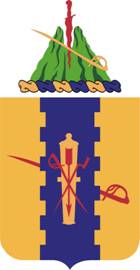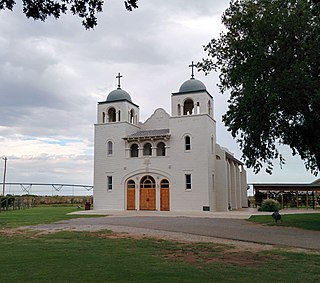Related Research Articles

Buffalo Soldiers originally were members of the 10th Cavalry Regiment of the United States Army, formed on September 21, 1866, at Fort Leavenworth, Kansas. This nickname was given to the Colored Cavalry by Native American tribes who fought in the Indian Wars. The term eventually became synonymous with all of the African-American regiments formed in 1866:

The 7th Cavalry Regiment is a United States Army cavalry regiment formed in 1866. Its official nickname is "Garryowen", after the Irish air "Garryowen" that was adopted as its march tune.

Human habitation in the Sierra Nevada region of California reaches back 8,000 to 10,000 years ago. Historically attested Native American populations, such as the Sierra Miwok, Mono and Paiute, belong to the Uto-Aztecan and Utian phyla. In the mid-19th century, a band of Native Americans called the Ahwahnechee lived in Yosemite Valley. The California Gold Rush greatly increased the number of non-indigenous people in the region. Tensions between Native Americans and white settlers escalated into the Mariposa War. As part of this conflict, settler James Savage led the Mariposa Battalion into Yosemite Valley in 1851, in pursuit of Ahwaneechees led by Chief Tenaya. The California state military forces burned the tribe's villages, destroyed their food stores, killed the chief's sons, and forced the tribe out of Yosemite. Accounts from the Mariposa Battalion, especially from Dr. Lafayette Bunnell, popularized Yosemite Valley as a scenic wonder.

Frederick William Benteen was a military officer who first fought during the American Civil War. He was appointed to commanding ranks during the Indian Campaigns and Great Sioux War against the Lakota and Northern Cheyenne. Benteen is best known for being in command of a battalion of the 7th U. S. Cavalry at the Battle of the Little Bighorn in late June, 1876.

Major General Hugh Lenox Scott was a United States Army officer. A West Point graduate of 1876, he served as superintendent of West Point from 1906 to 1910 and as Chief of Staff of the United States Army from 1914 to 1917, which included the first few months of American involvement in World War I.

The 1st Cavalry Regiment is a United States Army regiment that has its antecedents in the early 19th century in the formation of the United States Regiment of Dragoons. To this day, the unit's special designation is "First Regiment of Dragoons". While they were the First Regiment of Dragoons another unit designated the 1st Cavalry Regiment was formed in 1855 and in 1861 was re-designated as the 4th Cavalry Regiment. The First Dragoons became the 1st Cavalry Regiment since they were the oldest mounted regiment.

The 4th Cavalry Regiment is a United States Army cavalry regiment, whose lineage is traced back to the mid-19th century. It was one of the most effective units of the Army against American Indians on the Texas frontier. Today, the regiment exists as separate squadrons within the U.S. Army. The 1st Squadron of the 4th Cavalry's official nickname is "Quarterhorse", which alludes to its 1/4 Cav designation. The 3rd Squadron of the 4th Cavalry's official nickname is "Raiders". Today, the "1st Squadron, 4th Cavalry", "2nd Squadron, 4th Cavalry", "4th Squadron, 4th Cavalry", and "6th Squadron, 4th Cavalry" are parts of the 1st Infantry Division, while the "3rd Squadron, 4th Cavalry" serves as part of the 25th Infantry Division. On 23 September 2009, the "4th Squadron, 4th Cavalry" officially stood up at Fort Riley, Kansas as part of the 1st "Devil" Brigade, 1st Infantry Division. On 28 March 2008, the "5th Squadron, 4th Cavalry" officially stood up at Fort Riley, Kansas as part of the 2nd "Dagger" Brigade, 1st Infantry Division. The 6th Squadron, 4th Cavalry served as part of the recently inactivated 1st Infantry Division, 3rd "Duke" Brigade, at Fort Knox, Kentucky. The 1st and 5th Squadrons are assigned to their respective Brigade Combat Teams in the 1st Infantry Division. The 4th Squadron was inactivated in October 2015. The 3rd Squadron is assigned to the 3rd Brigade Combat Team in the 25th Infantry Division.

Yosemite West is an unincorporated community of resort homes located just outside the southern area of Yosemite National Park, just off Wawona Road, a continuation of State Route 41 from Fresno. It is situated one mile (1.6 km) south of the Chinquapin intersection of Wawona Road with Glacier Point Road at an altitude of 5,100–6,300 ft (1,600–1,900 m). The elevation reported by the USGS is 5,866 feet (1,788 m). The community is part of Henness Ridge, nearly 3,000 feet (910 m) above the southern banks of the Merced River and State Route 140 from Mariposa. Addresses in this area are shown as "Yosemite National Park, CA 95389"

The Great Sioux War of 1876, also known as the Black Hills War, was a series of battles and negotiations that occurred in 1876 and 1877 in an alliance of Lakota Sioux and Northern Cheyenne against the United States. The cause of the war was the desire of the US government to obtain ownership of the Black Hills. Gold had been discovered in the Black Hills, settlers began to encroach onto Native American lands, and the Sioux and the Cheyenne refused to cede ownership. Traditionally, American military and historians place the Lakota at the center of the story, especially because of their numbers, but some Native Americans believe the Cheyenne were the primary target of the American campaign.
Eugene Beauharnais Beaumont was a Union Army officer in the American Civil War and a recipient of the United States military's highest decoration, the Medal of Honor, for his actions at an engagement on the Harpeth River in Tennessee and at the Battle of Selma. After the Civil War he served in the Indian Wars of the western United States.

John Chowning Gresham was an officer in the United States Army who was a recipient of the Medal of Honor for his actions during the Indian Wars.

The Northern Cheyenne Exodus, also known as Dull Knife's Raid, the Cheyenne War, or the Cheyenne Campaign, was the attempt of the Northern Cheyenne to return to the north, after being placed on the Southern Cheyenne reservation in the Indian Territory, and the United States Army operations to stop them. The period lasted from 1878 to 1879.

Fort Meade is a former United States Army post located just east of Sturgis, South Dakota. The fort was active from 1878 to 1944; the cantonment is currently home to a Veterans Health Administration hospital and South Dakota Army National Guard training facilities. Much of the former reservation is now managed by the Bureau of Land Management as the Fort Meade Recreation Area. It is also home of Fort Meade National Cemetery. Fort Meade was established in 1878 to protect illegal white settlements on the Great Sioux Reservation in the northern Black Hills, especially the nearby gold mining area around Deadwood. Several stage and freighting routes passed through Fort Meade en route to Deadwood.

Henry Conger Pratt, professionally known as H. Conger Pratt, was a major general in the United States Army. He was awarded a Distinguished Service Medal with one oak leaf cluster, and received awards from Italy, Brazil, and England. He is the only person in American military history to command both an air force wing and an army division.

Fort McKinney (1877–1894) was a military post located in North Eastern Wyoming, near the Powder River.

Cantonment Reno also known as Fort McKinney 1 was a US Army post or cantonment located on the Powder River near the old Bozeman Trail crossing. A previous fort near the site had been abandoned and burned after the Fort Laramie Treaty of 1868. Cantonment Reno was re-established in late 1876, just upstream of the site of old Fort Reno. Cantonment Reno started as a temporary base of operations for General George Crooks' 1876 Big Horn Expedition,. Crook's Expedition was part of the intensive campaign against the Sioux and Cheyenne in late 1876, following Custer's defeat at the Battle of the Little Bighorn.

The Darlington Agency was an Indian agency on the Cheyenne and Arapaho Indian Reservation prior to statehood in present-day Canadian County, Oklahoma. The agency was established in 1870. The agency established at Fort Supply the previous year was moved to a more accessible location for the tribes. Brinton Darlington, a Quaker for whom the agency was named, was the first United States Indian agent at the agency, a position he held until his death in 1872.

Winfield Scott Edgerly was an officer in the United States Army in the nineteenth and twentieth centuries. Born in New Hampshire in 1846, he attended the United States Military Academy, graduating in 1870. He served on the frontier through the Indian Wars, including the Battle of the Little Big Horn and the Wounded Knee Massacre; in the Spanish–American War; in the Philippine Insurrection; and (briefly) in World War I. He served in several command positions. He was an observer of the Kaiser Maneuvers in Germany in 1907. He was retired as a brigadier general for disability in 1909, was recalled briefly in 1917 and died in 1927. Edgerly is buried at Arlington National Cemetery.
Douglass Taft Greene was a major general in the United States Army during World War II. He served as commanding general of the 16th Armored Division and the 12th Armored Division during their training in the United States. Despite being an officer during both World War I and World War II, he never held a combat command, and was assigned to active duty positions within the continental United States during both wars.

George King Hunter was a career officer in the United States Army. A veteran of the American Indian Wars, Spanish–American War, Philippine–American War, and World War I, he was a recipient of the Silver Star and attained the rank of Brigadier General.
References
- 1 2 Schaffer (1999), p. 50
- ↑ Heitman (1903), p. 1054
- 1 2 3 4 5 6 Cullum (1891), pp. 189-190
- ↑ Maddux (2003), pp. 68-72
- ↑ Maddux (2003), pp. 86-93
- 1 2 Rodenbough (1890), pp. 216-219
- ↑ Cullum (1900), p. 218
- 1 2 3 Hampton, H. Duane (1971). How the U.S. Cavalry Saved Our National Parks. Indiana University Press. Retrieved 2013-01-04.
- 1 2 Smith, David A. (2009). "Yosemite: The Cavalry Years". The California State Military Museum. Retrieved 3 January 2013.
- Cullum, George W. (1891). Biographical Register of the Officers and Graduates of the United States Military Academy at West Point, New York. West Point, New York: USMA Digital Library. Volume III
- Cullum, George W. (1900). Biographical Register of the Officers and Graduates of the United States Military Academy at West Point, New York. West Point, New York: USMA Digital Library. Volume IV
- Hampton, H. Duane (1971). "Chapter 8: The Extension of the System: Yosemite, Sequoia and General Grant National Parks". How the U.S. Cavalry Saved Our National Parks. Indiana University Press. Retrieved 2013-01-04.
- Heitman, Francis B. (1903). Historical Register and Dictionary of the United States Army From Its Origin September 29, 1789, to March 2, 1900 Volume I, House of Representatives, 66th Congress, 2d Session.
- Maddux, Vernon R. (2003). In Dull Knife's Wake: The True Story of the Northern Cheyenne Exodus of 1878, Horse Creek Publications. ISBN 0-9722217-1-9
- Rodenbough, Theophilus F. (1896). "Fourth Regiment of Cavalry". The Army of the United States Historical Sketches of Staff and Line With Portraits of Generals-in-Chief. United States Army Center For Military History. Retrieved 2013-01-04.
- Schaffer, Jeffrey P. (1999). Yosemite National Park: A Natural History Guide to Yosemite and Its Trails. Berkeley: Wilderness Press. ISBN 0-89997-244-6.
- Smith, David A. (2009). "Yosemite: The Cavalry Years". The California State Military Museum. Retrieved 3 January 2013.